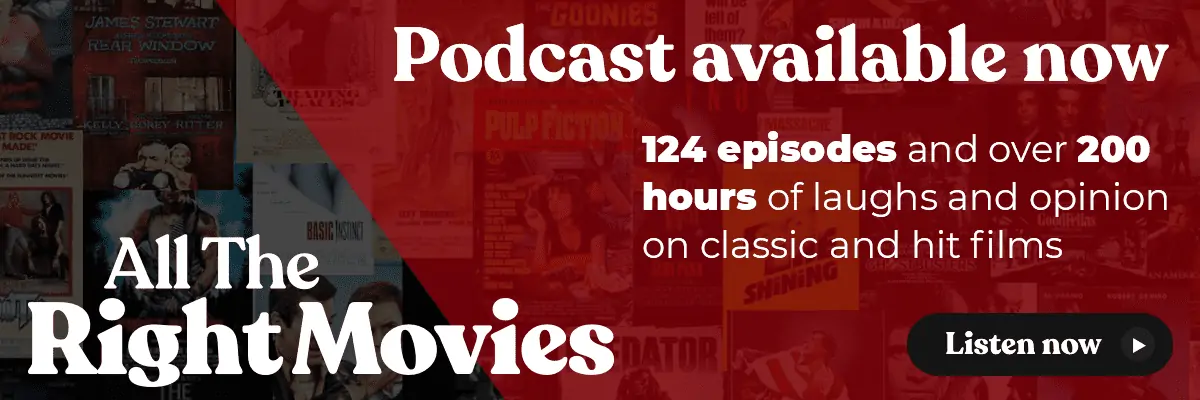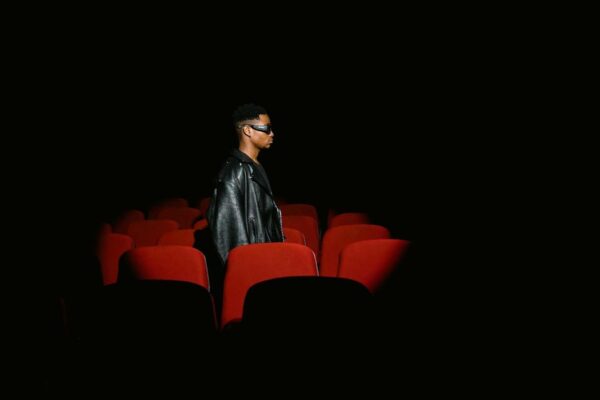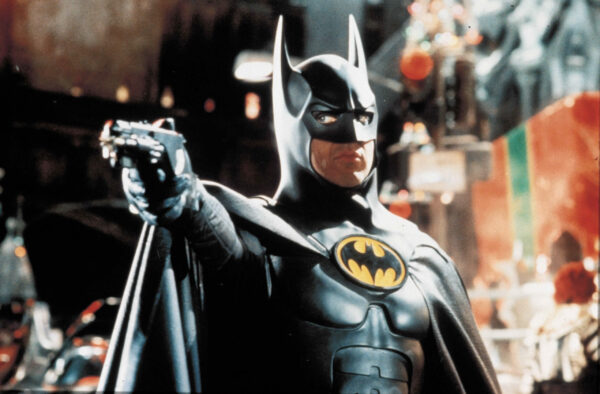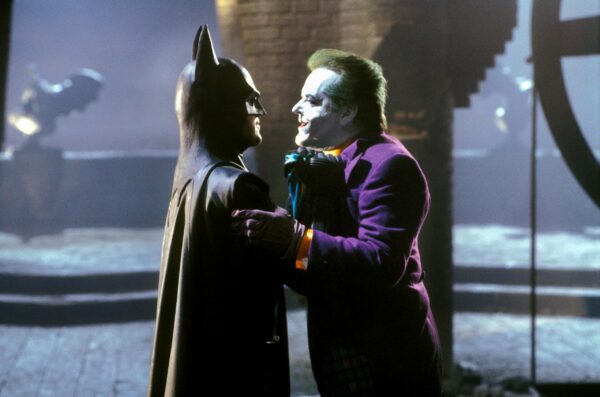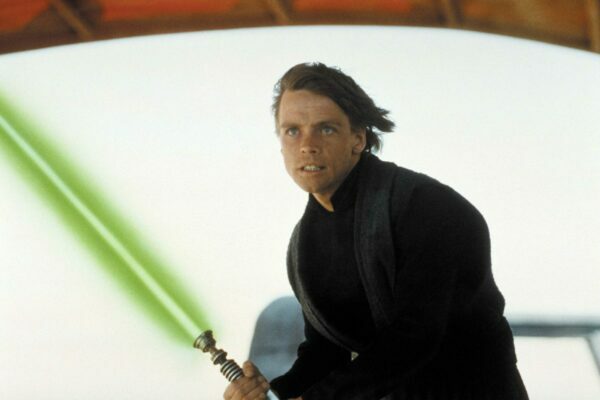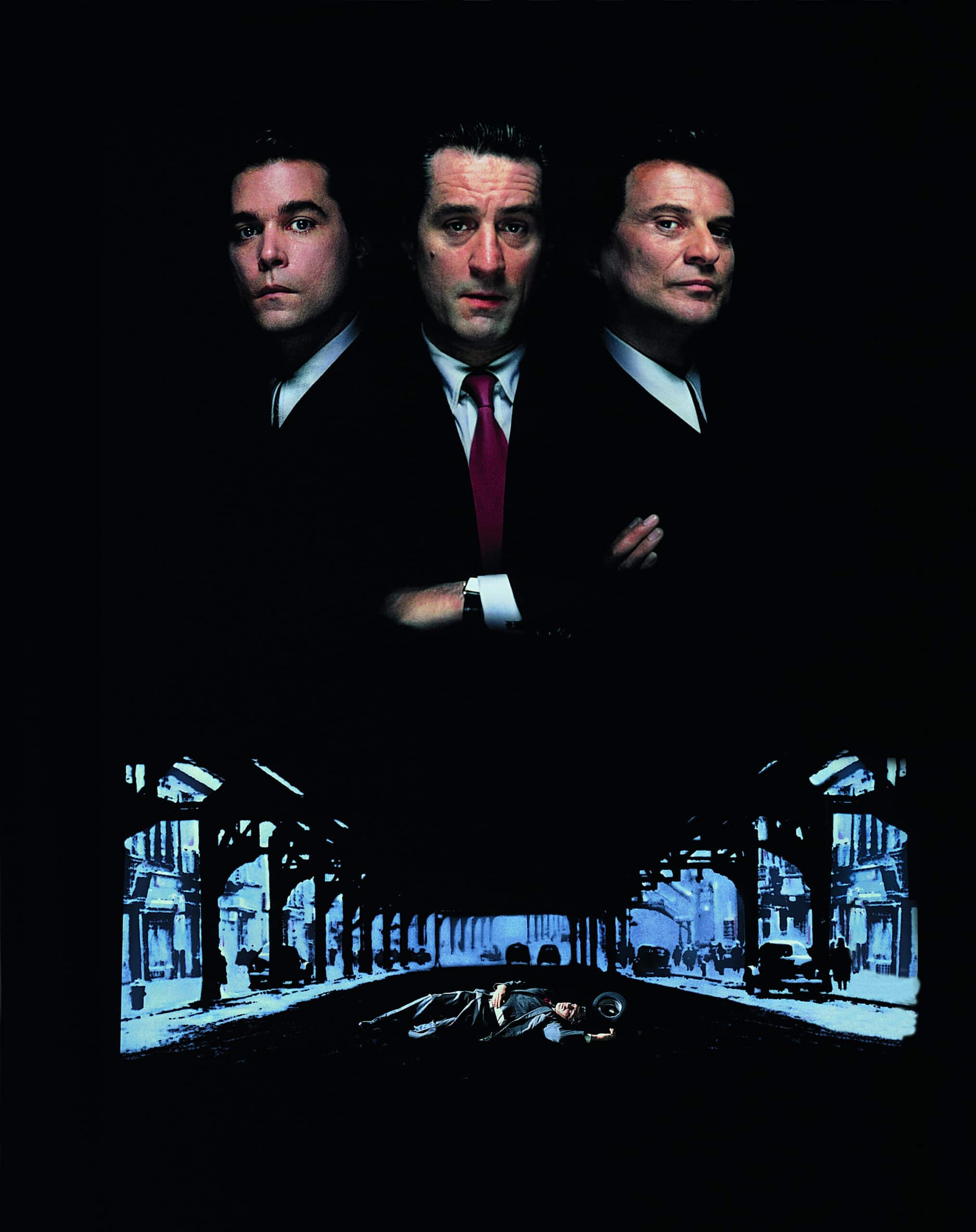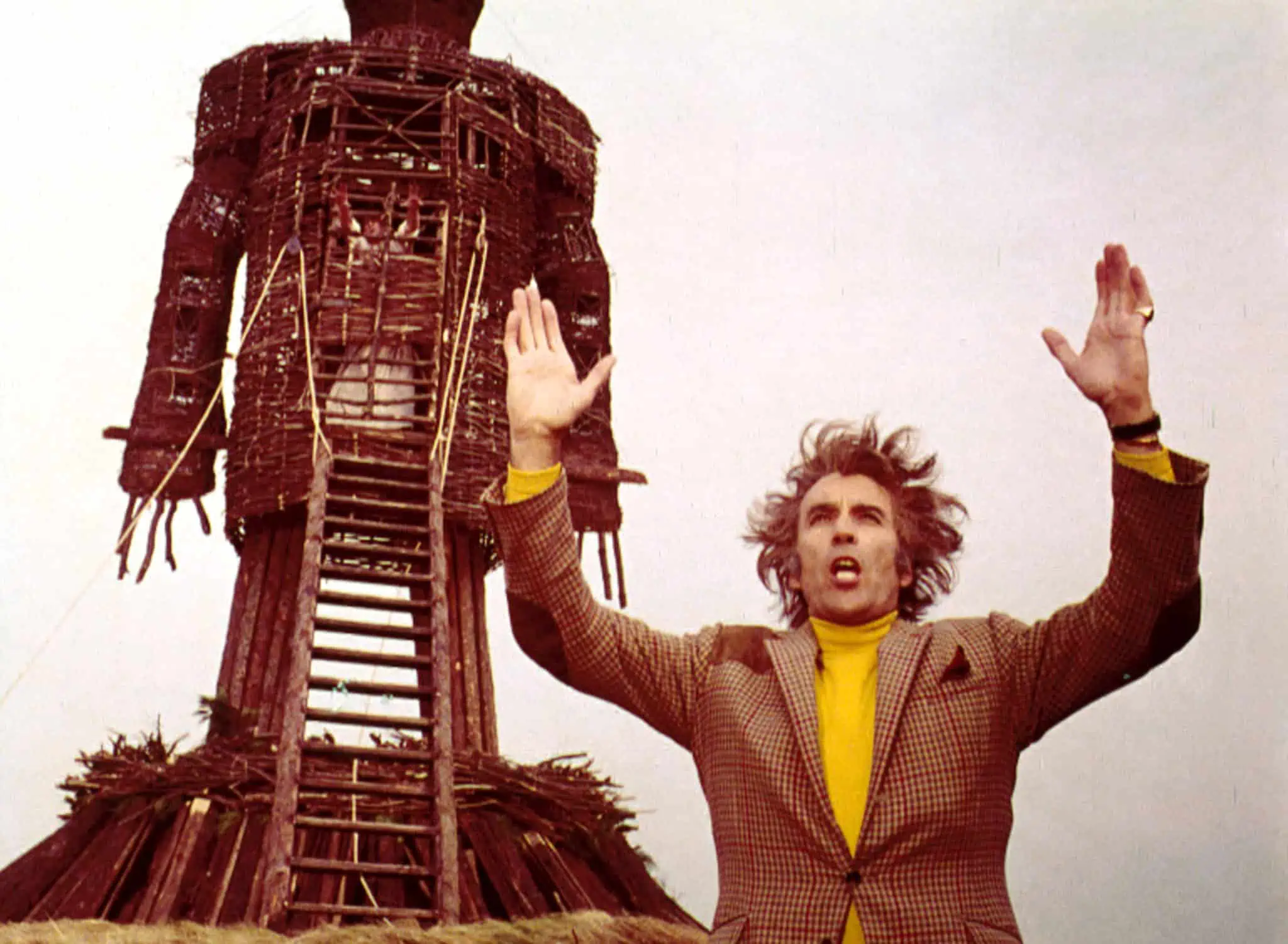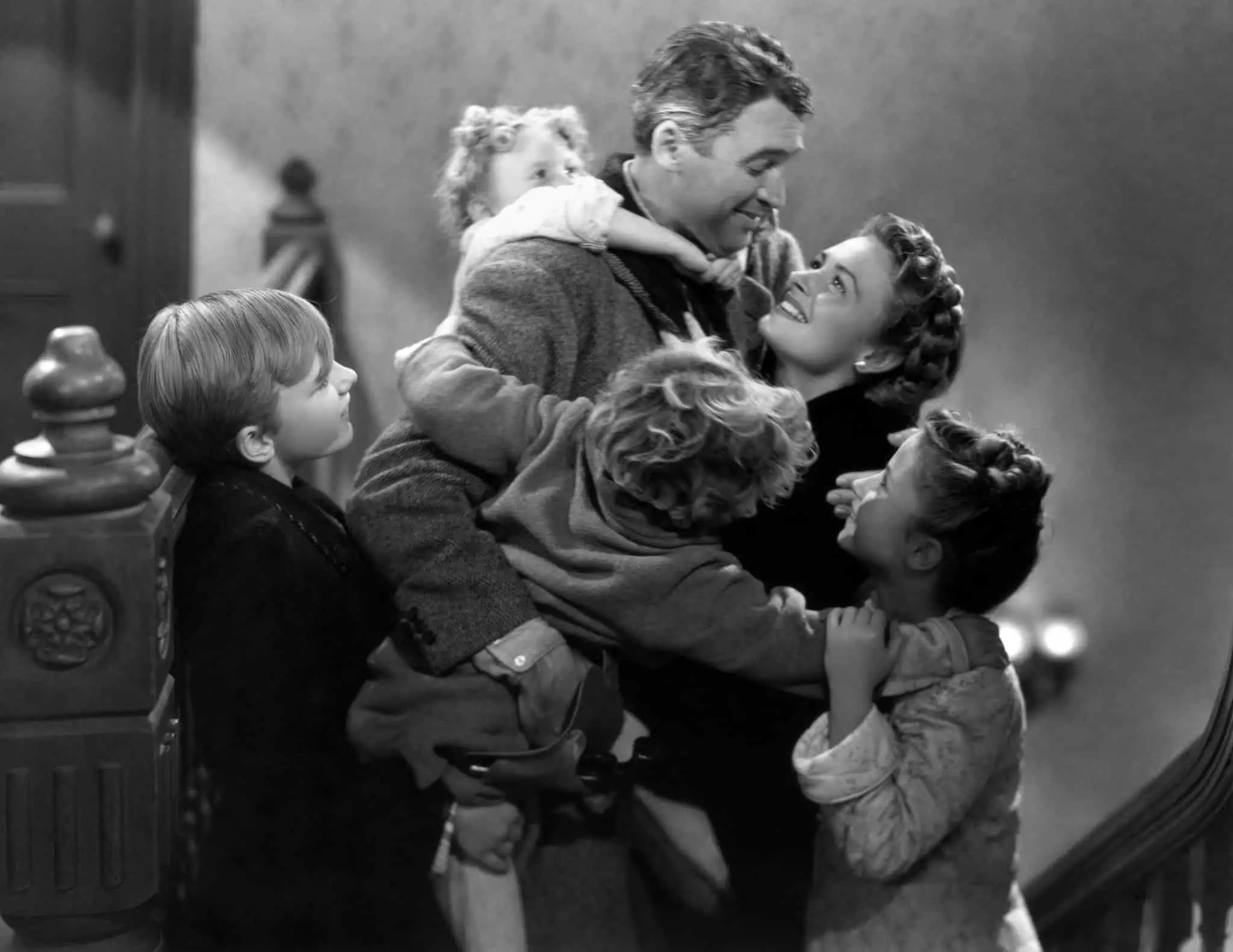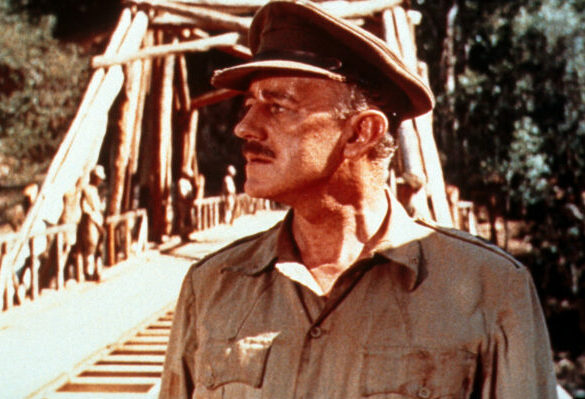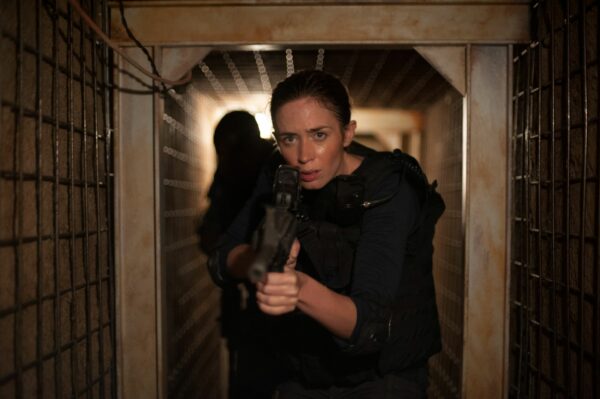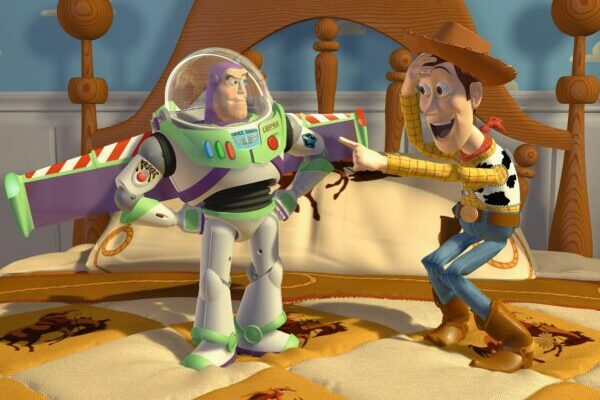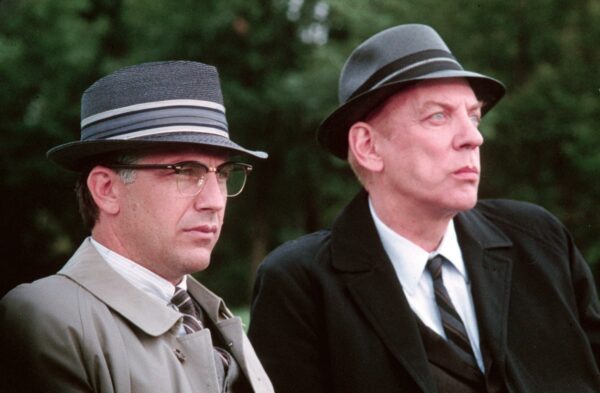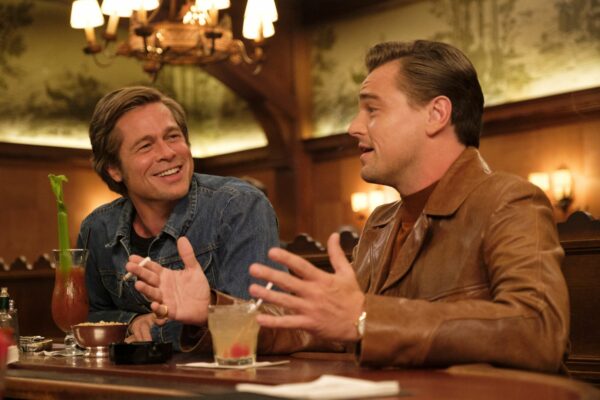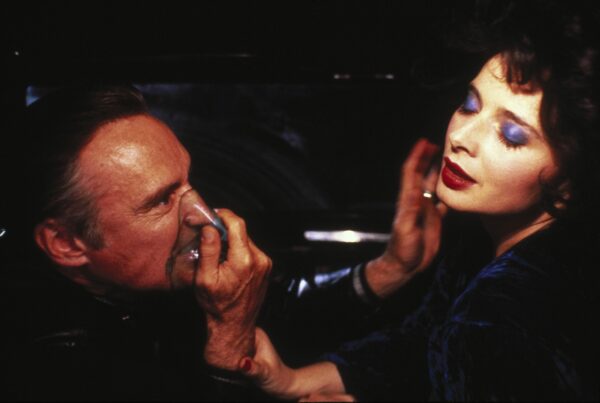
Rocky is possibly the greatest sports movie ever made, and it made a superstar out of Sylvester Stallone. We’ve got the incredible behind the scenes story on the classic movie via 25 amazing, enlightening facts.
Rocky was released in the winter of 1976 but not much was expected of John G Avildsen’s low budget tale of a down on his luck journeyman boxer who gets a one in a million shot at the title. However, audiences fell in love with the character of Rocky Balboa, and the relatable story at the heart of Sylvester Stallone’s all or nothing screenplay. It went on to win Best Picture and Best Director at the Oscars, and spawned one of the most successful franchises in movie history.
The behind-the-scenes production of Rocky is as remarkable as the film itself, and we’ve got the full story for you here, by way of 25 amazing facts.
1. A million to one shot
Sly Stallone was down and out in the mid-70s. He’d been in movies since the late 60s, but they were mostly extra work or small-time gigs. Stallone was broke, with just over $100 to his name and his wife was pregnant. He thought the only way to make it was to create the space for himself by writing a screenplay.
One night, Sly was watching a heavyweight title fight on TV, Muhammad Ali Vs journeyman boxer, Chuck Wepner, nicknamed The Bayonne Bleeder. It was Ali’s first fight after The Rumble In The Jungle and was billed as Give The White Guy A Chance. As you can gather by the title, nobody gave the Bleeder any shot, but Sly was taken by his heart. He knocked Ali down in 9th, but ultimately lost in the 15th by TKO. But he showed so much courage, it gave Sly all the material he needed for his new film.
Chuck Wepner’s 9th round knockdown of Muhammad Ali
2. Big changes were made to the original script
Stallone’s first draft was written in three and a half days, but was nowhere near what we see on screen. Only about 10% of it made the shooting script, and there were a further nine significant re-writes. In the first draft, Adrian was Jewish and lived with her mother who hated Rocky. Mickey was a vicious racist, Apollo was Jamaican, and Rocky threw the fight at the end and, with his prize money, opened a pet store with Adrian.
3. The film originally started differently
Producers Robert Chartoff and Irwin Winkler met Sly as a favour to his agent but he wasn’t right for the role they had. He told them that he had some screenplays he’d written; they rejected the one that became Paradise Alley (1978) but liked his underdog boxing idea. Chartoff and Winkler took it to United Artists who also liked it but did not want Sly in the lead because he was an unknown. They had in mind Burt Reynolds, Ryan O’ Neal or James Caan for the lead and offered Sly $75,000 for the screenplay.
Stallone wouldn’t budge and the offer kept on increasing, it went up to $340,000. He said “I didn’t know that much money existed. They kept insisting they needed a big-name star, but the story was about not selling out, about going the distance as a million-to-one shot. I never would have sold it … I’d rather bury it in the backyard and let the caterpillars play Rocky.” Finally, United Artists relented, they slashed the budget from $2 million to $1 million and allowed Sly to star after watching The Lords Of Flatbush (1974) but they mistakenly thought they were casting Perry King, another actor from that film.
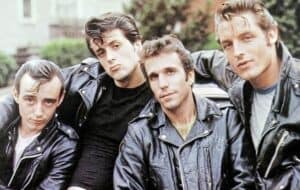
Stallone with Perry King (far right) in The Lords Of Flatbush (1974)
4. Originally the title character had a different name
In Sly’s first draft, the main character was called Robert Balboa, but Sly took inspiration from Rocky Marciano and tweaked it. Can you imagine the film being called simply, Robert?!
5. Stallone proved to be a shrewd negotiator
Stallone’s salary for Rocky was a paltry $20,000 for the script and $350 a day during filming (under $30,000 in total). But he also negotiated 10% of the film’s gross, meaning he earned around $22 million.
6. Casting alternatives
For the part of Adrian, Carrie Snodgress was first choice but asked for too much money. Susan Sarandon also auditioned but was deemed too sexy for the part. Talia Shire came in at the last minute and saved the day. She was given a tiny amount from the budget to go to a thrift store to come up with Adrian’s signature hat, glasses and coat look. The rest of her costumes were her own clothes.
For the part of Paulie, Stallone originally thought of Harvey Keitel, but the producers wanted Burt Young from the get go. He said “I was hanging out in my bowling alley in Queens the first time I read it. I knew it was a home run. How does a stumblebum wind up fighting for a championship? I used to be a fighter. It’s a fairy tale done for grown-ups.”
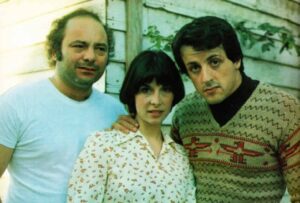
Burt Young, Talia Shire and Sylvester Stallone on set
7. History played a part in Philadelphia as a setting
Before signing on to be the director of the film, John G. Avildsen had never seen a boxing match or boxing movie, but he loved the characters and the underdog story. When he signed on in September ’75, he went to Philadelphia to scout locations, he said it was a historic “Goldilocks kind of town.” And the film being set in Philly is significant because it was set around the bicentennial, 200 years after the declaration of independence, which itself was signed at Independence Hall in Philly.
But producers of the film wanted to shoot in LA to keep the costs down, as they were personally liable for any costs that ran over the $1 million budget allotted by the studio. Avildsen and Stallone were adamant about shooting in Philly and got their wish.
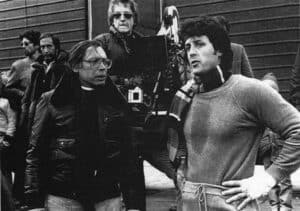
Stallone on set with producer Irwin Winkler
8. Stallone got a helping hand from his family
Because the budget was low, Sly filled in some of the minor roles with family members. His brother Frank Jr plays one of the street corner singers, his Dad, Frank Sr., is the timekeeper in the fight at the end. And his then wife, Sasha, was the still photographer on set.
9. A true underdog story
Rocky’s dog in the film, Butkus, was Stallone’s actual dog. As mentioned, he was struggling for money before selling the Rocky script, and had to sell his beloved dog for $40. When he sold the script, he bought him back. In Sly’s words “I couldn’t fight him, they’d arrest me, so I offered to pay double. Anyway, $3,000 and several threats later. I got the dog back.”
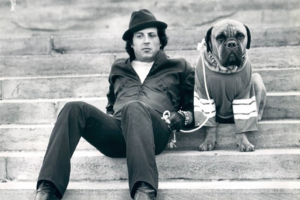
Stallone and Butkus
10. Avildsen got creative with the budget
The budget was miniscule so there were no trailers or upmarket catering; the cast and crew lived on a diet of pizzas and cheeseburgers for 4 weeks. Avildsen didn’t have official permits to shoot in the city, so he and his crew would ride around the streets of Philly in a van, find a colourful looking location, get out and shoot. The shot of Rocky running along the docks is an example of shooting on the fly.
11. A train in the distance
One thing that you might notice is that there are a lot of shots with trains going by in the distance, this was on purpose. A production assistant would stand by the tracks, and, with a walkie talkie, would radio in to Avildsen when the trains were coming so he could call action.
12. Burt Young went method for his role
Burt Young said that for the part of Paulie, he just took his usual lack of quality and slowed it down a notch or two. But it wasn’t as simple as that, Young really went method with the character. He dowsed his neck in sweet Vermouth so he would smell like cheap wine, to remind himself how much of a bum Paulie was. Young wore layers of clothes and padding so it was hard for him to move, and dipped his hands in turpentine making them feel tight, he had the idea that Paulie was riddled with arthritis.
He also studied real drunks to capture their movements and foggy thinking. But when it came to doing the scene where he walks home drunk, an actual drunk wandered on set and said he was doing it all wrong. Young took pointers from him and put them into that scene.
Burt Young as Paulie Pennino
13. The ice-skating scene could have looked very different
The location of the first date between Rocky and Adrian was originally going to be at a restaurant. Sly re-wrote the scene after Avildsen told him the characters should be moving around. The scene itself was supposed to have around 300 extras, but they didn’t have the money in the budget so he came up with this after-hours scene.
Sly couldn’t skate, so Avildsen’s suggestion was to have him jog round while Adrian was skating. And the majority of the written dialogue was discarded, leaving the uncomfortable first date spaces.
Rocky and Adrian’s first date on the ice
14. The film helped bring a game changing innovation to the big screen
Avildsen had heard about a new innovation by inventor Garrett Brown, who had shot some proof-of-concept footage for his new Steadicam. He filmed his then girlfriend, now wife, up and down the Philadephia Museum Of Arts Steps. Avildsen drafted Brown in and the Steadicam was used to capture fluid motion of the training and boxing scenes without the, often disorientating, shaky camera effect of a handheld camera.
The impact of the Steadicam on the film industry is immeasurable, and it is still in use today. Rocky was only the third time it was used in a major film, after Bound For Glory and Marathon Man, both from 1976.
Garrett Brown’s proof of concept Steadicam footage
15. Extras in the training montage
The people in the training montage weren’t extras, but passers-by who got whipped up in the excitement of it. A stall owner threw an orange at Sly during filming, and he caught it. That made it into the film but the stall owner didn’t know what the film was or who Sly was.
Stallone got injured during this training session, he pulled a tendon and was taken to hospital on a wheelbarrow.
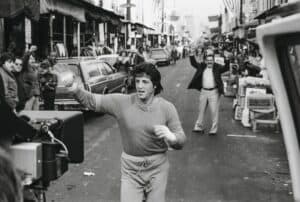
Sly running through the streets
16. Taking inspiration from one the greats
Rocky’s iconic run up the Philly Museum Of Art Steps and punching meat at the factory was pinched from Smokin’ Joe Frazier’s pre-fight routine. Smokin’ Joe does have a little cameo as a guest of honour before the fight at the end, and he was a little disappointed that he only got a fee for his cameo and not recognition for the other stuff. Avildsen tried to get other heavyweights to appear in the end scene but Smokin’ Joe was the only one who showed up.
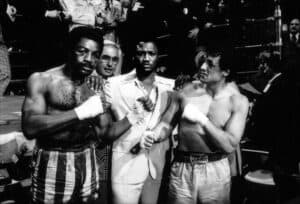
Stallone with Carl Weathers and Smokin’ Joe Frazier
17. Production mistakes allowed for script re-writes
Originally, the mistake that Rocky points out in the giant posters for the big fight wasn’t in the shooting script. But there was actually a mistake made by the production team, meaning that the scene had to be re-written to accommodate. Avildsen said that it allowed for the exchange between Rocky and Jergens, and reinforced that they didn’t care about Rocky; he was a pawn in their game.
Similarly, the gag that the robe Rocky wears is too big, wasn’t in the script. The wardrobe department messed up and sent a robe, in Sly’s words, “built for Godzilla.” The script was re-written to accommodate that also.
Rocky visits the venue the night before the fight
18. Carl Weathers got rough with Stallone during his audition
In his audition for the part of Apollo Creed, Carl Weathers sparred with Stallone and accidentally clocked him on the chin. Sly told him to calm down and Weathers replied “if I was allowed to audition with a real actor, I could do much better.” Avildsen told him that Sly was the guy and he replied “well, maybe he’ll get better.” Sly offered him the role on the spot.
Behind the scenes footage of Stallone and Weathers choreographing the big fight
19. The fight wasn’t shot in Philadelphia
Despite it all being shot and set in Philly, the fight itself took place at an arena in LA, not The Spectrum in Philly. To get a sizable crowd on a budget, ads were put out to the public that anyone who showed up would get a free chicken dinner. 4,000 people turned up for their free food and to see the filming of the fight. But that was nowhere near enough to fill the entire 8,000 seat stadium, so Avildsen dimmed the lights so that the viewers’ attention was focused only on the ring. He also used some stock footage of crowds at Madison Square Garden and inserted them in.
Rocky vs Creed
20. The film originally had a different ending
In the original ending, Rocky meets Adrian in the tunnel, and they walk out hand in hand. Test audiences said it was too depressing, so it was re-shot. They had very few people to fill the crowd for the re-shoot, they just used family, friends and crew in this one corner of the ring. But that image of Rocky and Adrian hand in hand was used for the poster art for the film.
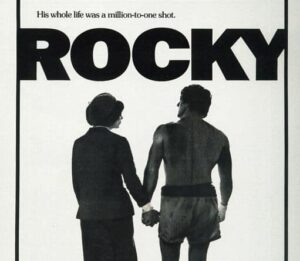
The original one sheet for Rocky
21. Bill Conti’s musical talent wasn’t the main reason he was chosen as the composer
Sly said “When I wrote the script for Rocky, I wanted passion music. I wanted a symphony of powerful men, of lonely women, of thick-necked losers, of human ships that crash in the night. Of love, courage and dignity cast in bronze.” The budget for the music was $25,000, and Bill Conti was chosen purely and simply because he was the cheapest.
Sly described his first time hearing the music that Bill Conti provided for the film: “The music began. I was sweating. I am impossible to satisfy, I thought. And then I was cheering! How did this thin man with an Afghan dog, seize the soul of every character and set it to music?! Then it dawned on me. Simple. How could I have not known at our first meeting that he was brilliant: Bill Conti is Italian.”
Bill Conti’s iconic Gonna Fly Now Rocky theme
22. Stallone got an unexpected response during a test screening
Sly had a test screening of Rocky for The Director’s Guild. This was the big one he thought, he needed a positive reaction. But he said “The laughs weren’t coming where they were supposed to. The fight scenes seemed to be listless, as the response was. And I just sat there, as everyone left the theatre, and I couldn’t believe it. I really blew it. I was humiliated.”
He walked out of the theatre, down the stairs, a broken man. He came through the doors and there was everyone from the theatre standing around him, and they broke out in applause.
23. The film made Oscar history
Rocky was the first sports movie to ever win an Oscar for Best Picture and Stallone remains the last person in Oscar history to be the sole writer of an original screenplay, to have starred in the lead, and be nominated for both. The only other person to do that was Charlie Chaplin, and coincidentally, Chapers was a huge fan of Rocky. He invited Sly out to visit him in Switzerland, Sly declined and came to regret it after Chaplin died a few months later. Sly did the same to Elvis Presley who was a fan, he invited him to screen Rocky in Memphis, Sly declined and The King died a few months later.
Rocky wins Best Picture at the 1977 Oscars
24. Stallone’s shady past came back to haunt him
Rocky’s nickname, The Italian Stallion, was co-opted for one of his earliest roles. The 1970 soft-core porn film The Party At Kitty And Stud’s was renamed The Italian Stallion and re-released to capitalise on Rocky’s success. It was distributed to theatres for $10,000 a night. Stallone commented “hell, for $10,000 forget the movie! I’ll be there myself!”
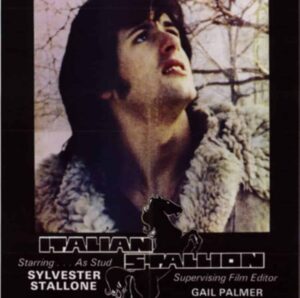
The re-release poster for The Party At Kitty And Stud’s
25. The Bleeder got his slice of the action
As mentioned earlier, Sly was partly inspired by Chuck ‘The Bleeder’ Wepner who grew increasingly angered by Sly’s success and his lack of. He went on to sue Stallone in 2003, with Sly settling out of court for an undisclosed fee. There was a 2016 film made of Wepner’s life starring Liev Schreiber, called Chuck, which covers his frustration and anger at the Rocky movies.
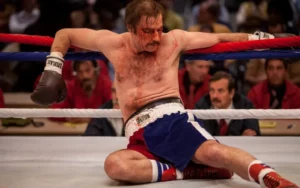
Liev Schreiber as Chuck Wepner in Chuck (2016)
And that’s the final bell – 25 incredible, fun facts about Rocky- one of the greatest sports movies ever made. Please share on your social media channels, and subscribe to our YouTube channel for lots of great video content.
The beginning of a beautiful friendship
Stay up-to-date with all things All The Right Movies by signing up for our e-newsletter.
